#dark matter physics
Text
So, I have a friend who is a physicist whose primary focus is Dark Matter. Well, I happened to come across a tiktok on a dark matter feud about cotton gravity. (Do not ask me what that means I have no fucking clue.) So I sent it to him and he admitted that he's been in one of these nerd fights. Which I was particularly tickled by so I told my girlfriend and they called the fights "Diss tracks (nerd edition)"
4 notes
·
View notes
Text
Scientists may soon be able to detect the most mysterious entity in the universe using a fleet of next-generation satellites, a new theoretical study suggests.
Dark matter — a poorly understood substance that does not emit, absorb or reflect light but exerts a clear gravitational influence on other matter — dominates the universe. Despite being more than five times more abundant in space than ordinary matter, dark matter's composition and properties remain entirely unknown.
Continue Reading.
150 notes
·
View notes
Text
Physics Friday: WTF is Dark Energy/Dark Matter? (Part 1)
To see what this is all about click here.
Preamble: Dark Numbers
Education level: High School (Y9/10)
Topic: Cosmology (Astronomy)
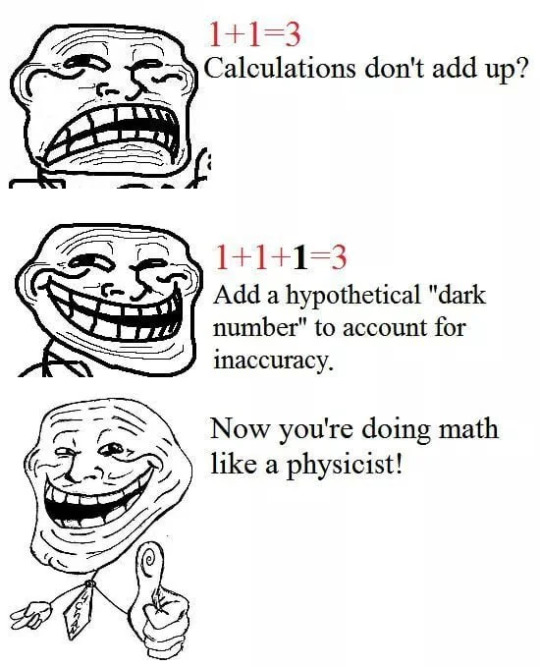
This equation is surprisingly the best representation of what we are doing with dark energy and dark matter. The equations we are using to figure out the nature of the universe are quite literally 'not adding up'.
When we have a situation where we encounter a missing number we are faced with three scenarioes:
Our model is wrong and we fucked up, physics is over
Our model works, but it's not complete. There are situations where it doesn't apply, and we are seeing an example of it
Our model is simply missing a few terms
Scenario 1 would imply that basic physics such as Newton's laws of motion and gravity are just plain wrong. Which is ... well ... a bit difficult to try and prove.
Scenario 2 implies that there is a more fundamental theory that underlies our current one. While it is not off the table, it can be difficult to find a theory for just one or two specific phenomena.
Scenario 3 is like 2, but it's a bit 'softer', what we're doing is just adding an extra number to balance out the equation and then trying to answer "What does this number mean"?
By Occam's razor, we can go with option 3, as it's simpler, and also appears to be more correct than a complete model change.
Dark Matter and Galaxies
Our galaxy is like the solar system in the sense that there is a large object in the centre surrounded by a bunch of stuff moving around that centre.
The difference between the two is the ratio between the central mass and the mass of the rest of the system.
If you combined all of the planets in the solar system together, it would still be less massive than the Sun.
This means we can easily calculate how the planets move around the Sun. As the motions of the other planets don't really affect that motion all too much. And thus we can use Kepler's 3rd Law:
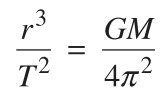
If you combined all of the stars in the galactic 'orb' surrounding the centre, you find that it would be much heavier than the black hole in the centre.
This means you have to account for a more spread out mass as you change your distance from the centre of the galaxy.
The further you are from the centre of the galaxy, the more stuff there is beneath you i.e. there's more stuff closer to the core than you. We have to calculate gravity taking this mass, and the radius to it, into account.
Thankfully, we have methods that can calculate this much easier. And we can use this to figure out our orbital velocity as a function of distance from the centre.
So let's try and calculate things! Take a galaxy, measure it's mass distribution independent of orbital mechanics, and find the orbital velocity!
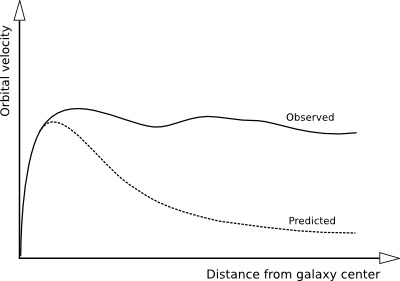
Image Credit: Citizendium
What we get is the graph above. In a normal universe, we expect our orbital velocity to increase near the core as more stuff gets added to the mass pulling us in. It then peters out as gravity looses it's strength.
What we actually see is that the orbital velocity takes a lot longer to peter out. If Newton's Laws/General Relativity are working how they should, this means that there must be a lot more mass in the galaxy.
What's worse is that this mass is much more evenly distributed. And not just that, but we cannot see it i.e. it does not interact with electromagnetic waves (light).
Hence we label this weird matter 'dark', because we can't see it and it helps us account for the disparity in the equation.
Next time I'll go into what we think dark matter actually is.
Dark Energy and Einstein's Blunder
General Relativity is one of the most backed-up theories in all of physics. The original conception of the theory comes from the Einstein Field Equations (EFEs):

We can safely ignore all of the fancy jargon symbols. What's important to us is what's missing.
When Einstein was playing around with his equations, he made an error. This error led him to missing a part in his equation. And thus he added an additional term to the EFEs:

This capital lambda term (Λ) helped balance his erronious equation.
Eventually, Einstein figured out that this was a mistake, a mistake so big that he called it his 'Biggest Blunder'. It turns out that the EFEs don't require Λ to actually work.
A few decades later, in the 1990s, researchers were trying to use the principles of general relativity to figure out the expansion of spacetime. Thanks to Edwin Hubble, we knew that space was expanding, but we didn't know how it was expanding.
The difficulty is that both the curvature and the amount of energy in the universe affected the expansion of the universe. This is dictated by the Friedmann equations:

Where the a's are the universe's scale factor, i.e. the current 'size' of the universe. The two p's are the mass and energy densities in the universe.
Using measurements of Type Ia Supernovae (you will see a topic on this in the future as I've done research into this), two teams of researchers were able to determine that the expansion rate of the universe was accelerating! Something completely unexpected.
This would require us adding an additional term to the equation involving our suspicious little friend:

This Λ variable, called the cosmological constant, can be propagated up the mathematical derivation chain to show that Einstein's 'mistake' was actually the correct equation all along!
The cosmological constant acts a energy density term that exists outside of our current understandings of the matter and energy in our universe. And because it's outside of our understanding, we call it 'dark' energy - because, just like dark matter, we can't see it.
It's a type of energy that isn't represented by any of the fundamental forces. What's more is that it is constant, which means as the universe expands, more gets added. And even more is that this energy density is negative, suggesting even that the universe is not a vaccum.
This discovery landed three researchers from both teams the Nobel prize in physics. One of the laureates includes the vice chancellor of my very own university, Brian Schmidt. Doxxing myself aside, this is a fact that neither me, nor my university, will shut up about.
In another part, I'll talk about what this dark energy could be and what an accelerating expansion of the universe could mean.
Conclusion
So despite the names, dark energy and dark matter are actually two different things that have two different sets of properties purposes (at least that's what we think). The names simply derive from the same method of using constants to help make our equations work better with reality.
It's always possible that we are wrong and there is a more fundamental equation that helps us understand these things. But that's a task for the future.
Hope you enjoyed reading and please give me feedback! I'm doing this every week as well, so feel free to follow if you want.
Next week I'll probably do something mathematics-related, before continuing on with this part.
#physics#astronomy#cosmology#dark matter#dark energy#physics friday#science#stem#academics#astrophysics
246 notes
·
View notes
Text
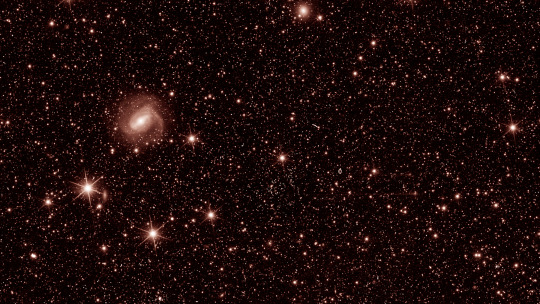
These are the first test views from Europe's new $1.4 billion space telescope. Euclid's purpose is to map out the dark side of our universe by analyzing billions of galaxies that reside up to approximately 10 billion light-years away.
Read more: https://rb.gy/mtire
#dark matter#dark energy#nasa#astronomy#astrophotography#solar system#astrophysics#hubble#physics#james webb images#james webb space technology#nebula#galaxies#guardians of the galaxy#europe
295 notes
·
View notes
Text
You ever think about Vash's angel arm ability and wonder where the stuff that it black-holes up goes? Because all that energy and mass is going somewhere. I feel like, reasonably, you could assume it goes to the higher dimension or whatnot, but also. It would be a wee bit fucked up if he absorbs and keeps all of the souls of the people he's decimated inside of him, wouldn't it?
#Trigun#Trimax#Trigun Maximum#Hell even#TrigunBookclub#Because it's a post from there that's got me thinking about it#AGAIN#I think about this ALL THE TIME#And it's about time I cursed y'all with it#(Also. I know dark matter is still hardly understood. I KNOW.)#(But Vash's ability was created with the understanding we have of physics in mind)
171 notes
·
View notes
Text
Space is a near-perfect vacuum, but it’s not entirely empty. A small list of matter include :
a few hydrogen atoms here and there (less than one hydrogen atom per cubic meter)
Dark Matter — an enigma that was recently discovered in the 20th century. It doesn’t interact with the normal matter that we’re used to (eg. solid, gas, liquid). We can’t see it since it doesn't interact with light or any electromagnetic radiation. However, it does exist and makes up about 27% of the universe.
Neutrinos — neutral subatomic particles with little mass and no electric charge. They’re from atoms that come together (nuclear fusion) or break apart (nuclear fission)
Electromagnetic radiation and magnetic fields
There are other things that exist in outer space but they’re usually not normal matter and don’t make space very dense at all. It’s okay because space is never truly empty but it can still be very close to empty, making it a far better vacuum than the best ones we can make on earth.
This is not an issue for electromagnetic waves (like light and radio waves) that can travel through space unhindered because they don’t need any medium to propagate.
Sound waves are different since they're mechanical waves, which is just vibrating matter. Hence, they need a medium to travel through to be heard. In space there is no air or medium for sound waves to travel through. This means that no one can hear you scream in space :)
#physics#astronomy#outer space#science#space#stem#galaxy#universe#astronauts have speakers in their suits that convert sound into radio waves so they’re good#existential thoughts#thoughts#ramblings#rambles#density#cosmos#space exploration#matter#dark matter#neutrino#waves#soundwave#electromagnetism#electromagnetic fields
31 notes
·
View notes
Text
Why isn't Natori's cousin arc talked about much ?
It was such a masterpiece of a story. it was very powerful and tragic which just hurts so much and I'm not over it or I'll ever be, it also had so many things to talk about .. like a lot for example:
-the undying trust Natori had for Natsume that no words reached his heart like Natsume's words
-that deep sad desire inside his heart which later on got crushed in the ugliest of ways not once but twice
-the fact that the Natori clan might have some secret that led people fearing their return or hating them which might be what led someone to break the barriers that protect their house ?
-Natori hating himself more and more for being weak and having such simple desire (NOOOOO PLEASE T^T)
-Natori pushing himself through his trauma for Natsume's sake !!!
-Natori's family being as worse as Natsume's relatives! I SO HATE THEM AS MUCH AS NATSUME'S RELATIVES!! THOSE COWRDS!!
-some more exorcist lore! "I thought he would wear a hat" pleaaase that killed me I can't see him doing it xDDD
-Natori's complicated emotions about the Matoba ><
-"Mitsuru was never going to be the family I dreamed of. If she had been born, she wouldn't have been my ally but my enemy" >> this simply shattered my heart to pieces that I remember I took moments off the pages to recomposed myself .. too much I just can't okay T^T
-big BIG BIG respect for Natori's resolve and pride as an exorcist even if that actually hurts him or cast him in the dark since I thought he might actually regret being an exorcist sometimes but aaaaaaaaaaaa that resolve !!! I was happy yet sad and crying !!!
-"I'm glad you're the one who exorcised me Natori Shuuichi" >> nope I'm okay not breaking down in tears or anything at all T^T
-a bit on Natori and his shiki's relationship T^T
-Natsume's respect for Natori's choice at the end that he didn't interfere and hating himself for not being able to find a solution for both ><
-WHAT WAS NATORI GONNA DO TO HIMSELF IF NATSUME DIDN'T APPEAR THIS IDIOT!!!!
I feel there's more things worth mentioning but those are what's on my mind right now, I so wanna expand on everything and talk much about them but can't with this very unstable health of mine for now T^T
must come back to it one day .. I must since this story is just another masterpiece from Midorikawa-sensei that need more people to talk about it .. no simple words can express what I feel about this arc ..
#natsume yuujinchou#natsuyuu#natori shuuichi#I think since this put such a heavy damage on Natori both physically and mentally#I won't blame him for not joining in the current arc no matter how much I wished he was#he need a rest#can you imaging how many heart attack he would've get if he joined in the current arc ? poor Natori#this story was too heavy that even I needed a rest after it ><#I so wish I can fully express everything -sigh-#it kinda of always break me down that I can't do what I want much cuz of this health of mine#but still the fact I manage to write here and there is still a big thing for me :)#plus this manga is like a ray of light in this darkness#they make me forget whatever pain I'm in#especially Seiji .. he's ..#or wait that's not the place to talk about this lol
51 notes
·
View notes
Text
I've never found the case for dark matter persuasive. It's just too much of a hand wave to excuse an otherwise brilliantly accurate theory. So, naturally, I'm always interested in attempts at alternate explanations.
So the paper from Kyu-Hyun Chae should be right up my street, right?
Breakdown of the Newton-Einstein Standard Gravity at Low Acceleration in Internal Dynamics of Wide Binary Stars
But look, I'm not qualified to judge most of the content. I'm not a gravitational theorist or any kind of actual scientist. So I have to go by metrics that I can comprehend and, well...
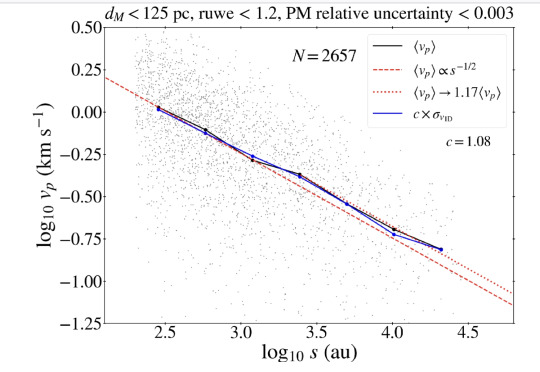
This graph represents the data behind the paper. The author claims, on the basis of simulations and averages, that those scattered data points fit the black line to a confidence of 10Σ. Ten. Sigma.
That's just. That's too outlandish a claim for me to entertain. It's ludicrous on the face of it.
Now if the scientific community at large comes to agree, then I'll be happy. Thrilled, even. But right now I just do not think that's plausible.
48 notes
·
View notes
Text
ARE THERE MORE THAN 1 UNIVERSE??
Blog# 198
Saturday, June 4th, 2022
Welcome back,
What – one vast, ancient and mysterious universe isn’t enough for you? Well, as it happens, there are others. Among physicists, it’s not controversial. Our universe is but one in an unimaginably massive ocean of universes called the multiverse.

If that concept isn’t enough to get your head around, physics describes different kinds of multiverse. The easiest one to comprehend is called the cosmological multiverse. The idea here is that the universe expanded at a mind-boggling speed in the fraction of a second after the big bang. During this period of inflation, there were quantum fluctuations which caused separate bubble universes to pop into existence and themselves start inflating and blowing bubbles.
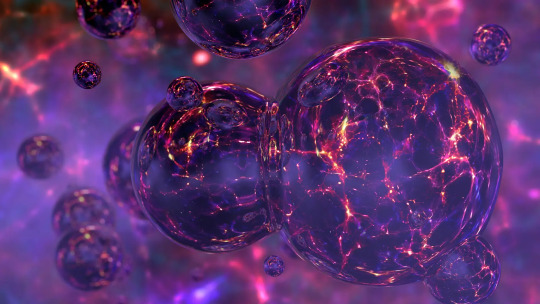
Russian physicist Andrei Linde came up with this concept, which suggests an infinity of universes no longer in any causal connection with one another – so free to develop in different ways.
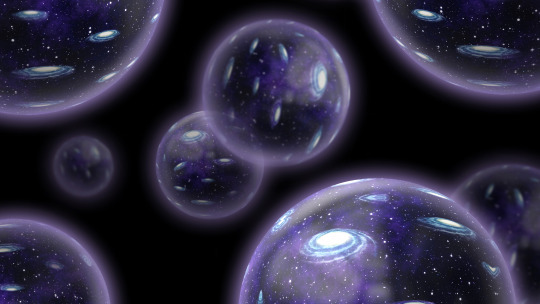
Cosmic space is big – perhaps infinitely so. Travel far enough and some theories suggest you’d meet your cosmic twin – a copy of you living in a copy of our world, but in a different part of the multiverse. String theory, which is a notoriously theoretical explanation of reality, predicts a frankly meaninglessly large number of universes, maybe 10 to the 500 or more, all with slightly different physical parameters.
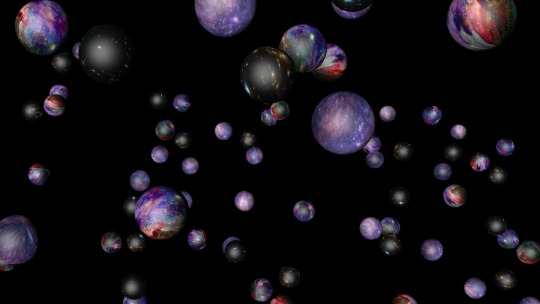
And then there’s the quantum multiverse. Physicist Hugh Everett came up with this idea, which is predicted by his “many worlds” interpretation of quantum physics. Everett’s theory is that quantum effects cause the universe to constantly split. It could mean that decisions we make in this universe have implications for other versions of ourselves living in parallel worlds.
Originally published on www.newscientist.com
COMING UP!!
(Wednesday, June 8th, 2022)
“WHAT IS THE NEW THEORY OF GRAVITY??”
#astrophotography#Astronomy#astrophysics#spacecraft#spaceX#outer space#space#alternate universe#universe#Parallel Universe#white universe#gravity#antimatter#strange matter#Dark Matter#science#physics#quantum physics#atmosphere
571 notes
·
View notes
Text
The search for dark matter
Post #6 on Physics and Astronomy, 06/10/23
Welcome back.
This time, I’m going to be talking about how astronomers and physicists have made an effort to detect and provide evidence for the existence of dark matter.
To recap from my first issue, it’s worth talking about what dark matter actually is. It’s a type of matter estimated to make up about 80% of the Universe’s matter. To date, it hasn’t been detected. Light passes straight through, it is assumed, however we infer the existence of such a substance due to its gravitational influence.
We can take an example from the Bullet Cluster. This is a pair of galaxy clusters that collided head-on a while ago. That pink mist you see in the photo is hot gas, and within it most of the regular matter. The blue mist, on the other hand, is dark matter, and where most of the mass of these two galaxies were in this photo.

Vera Rubin and Kent Ford
Vera Rubin and Kent Ford were two astronomers who had worked together to observe the Andromeda Galaxy, more specifically the rotational velocities of concentric regions from the center. The prediction was that, the further you looked from the center, the less the velocity of the stars within that region, since a greater centripetal force would be required to maintain a high-velocity orbit. This, however, was not the case.
It was observed that the velocity remained nearly constant the further you went out. Wait a minute, though, this didn’t make sense–that velocity was high enough, in theory, to make the stars fly off into space. But they weren’t.
These findings matched those of Fritz Zwicky. He was a Swiss astronomer who had studied the Coma galaxy cluster. He made the same observation–the speeds were so high that the stars should just have been flung off into space. His findings, however, were ignored.
Experiments to detect dark matter
So far, experiments to detect dark matter have been largely unsuccessful. Some of these include PICASSO, LUX-ZEPLIN, EURECA, FUNK, KIMS, DarkSide, Edelweiss, DARWIN, and DAMA/LIBRA, which is what I’m exploring next.
This detector in particular, introduced promising results which ended up the subject of dispute. DAMA/LIBRA, which hoped to capture activity from WIMPs (Weakly Interacting Massive Particles), returned a signal with a period of one year. This looked to be one step closer to affirming dark matter’s existence–however, COSINE-100, an experiment set up to mirror that of DAMA/LIBRA, could not reach those same results, which led to the belief that the signal detected could be from some other factor.
The search for dark matter is one that interests me very much. It’s like telling someone in the Stone Age that metal exists, and they should go find it. Except, dark matter is seemingly even more impossible to find, since we can’t perceive it, with the human eye or the best of our current technology. Which, I guess you could argue, would be exactly how the Stone Age person would have felt, but you understand my point.
That said, it’s something I’m eagerly watching. The day we find something promising? You’ll hear it first from me.
#physics#studyblr#astronomy#engineering#astrophysics#stem#sixth form#alevels#dark matter#dark energy#mathematics#physicsblr#mathsblr
50 notes
·
View notes
Text



A process has occurred!
#kirby#meta knight#gooey#gooey kirby#dark matter#dark matter kirby#dark matter swordsman#dark matter blade#elfilin#species swap#zephyr's artbook#I was going to give Meta curls like I've done with his gijinka but I decided against it#I was also going to make Blade's marks ressemble eyes with slits but I thought they were too distracting#And lastly Elfilin shouldn't have wings on account of being physically younger than Kirby#But I decided to break the rules a bit given his backstory#Plus it was either that or a scar near his eye#I figured wings worked better so I could take a chunk out of one of them
45 notes
·
View notes
Text
The current theoretical model for the composition of the universe is that it's made of normal matter, dark energy and dark matter. A new University of Ottawa study challenges this.
A study, published today in The Astrophysical Journal, challenges the current model of the universe by showing that, in fact, it has no room for dark matter.
In cosmology, the term "dark matter" describes all that appears not to interact with light or the electromagnetic field, or that can only be explained through gravitational force. We can't see it, nor do we know what it's made of, but it helps us understand how galaxies, planets and stars behave.
Continue Reading.
101 notes
·
View notes
Text
Physics Friday #4: WTF is Dark Energy/Dark Matter? (Part 2)
Important Note: 50 people is a lot! (well after I blocked all the bots it was under that). And I never expected it to grow so quickly. But also I've noticed that a lot of people move in and out of following this blog. And I think one reason is because some people just want to see the physics/maths/astronomy instead of that plus random shitposts.
So what I'm going to do, is for all future posts like this, put this in a second blog to separate it from this one. And every time I post to that one I'll re-blog it here so that there's space for those who just like to see science-y stuff.
The second blog is @oliviabutsmart.
Preamble
Education level: High School (Y9/10)
Topic: Cosmology, Particle Physics (Astronomy)
This is the second part of three to the Dark Energy vs. Dark Matter post. In this part, I'm going to cover the possible ideas behind what dark matter is.
From the last part, what you need to know is that:
Dark matter and dark energy are completely different things, they're both dark because we can't see it
When we look at galaxies and orbits, what we expect is that most of the mass is concentrated in the centre (galactic bulge)
What we actually end up seeing is that there's a lot more stuff in the outer reaches of the galaxy, and we can't see any of it
This hidden matter, called 'dark matter' is what we have to use to correct our equations
Introduction: The chad MACHO vs. the virgin WIMP
Now unlike what this tile says, I don't actually think that MACHOs are better, it's just a play on- .... you know what I mean.
So, given what we know, we need to find a source for this hidden matter. The best place to start is to take a look at what we do know about dark matter:
It doesn't interact with the electromagnetic force (or if it does, it's very rare) - this allows it to appear as 'invisible'
It does have mass - as it affects the motion of stuff in galaxies
It needs to be plentiful outside of galaxies
It generally doesn't interact with other forms of matter
So now we have three different candidate groups for dark matter:
Weakly-interacting particles, including WIMPs (weakly interacting massive particles)
Really big objects that happen to not radiate a lot (also known as MACHOs)
Modified theories of gravity on the large scale
We also need to worry about the way in which this matter is produced. Which is where the cold-warm-hot metric is introduced. It has less to do with temperature and more with speed, particularly in the early universe (see free streaming length for more details - I'm oversimplifying).
What's important is what this "free streaming length" does. Larger lengths corresponds to the formation of larger structures first, then smaller internal structures later.
A cold dark matter model corresponds to dark matter with a small speed in the early universe. In the current day, we think that this is the best model - as it allows for the formation of galaxies first, then clusters of galaxies later - something that we have observed.
Hot dark matter is on the higher end of the speed spectrum and is more equivalent to the formation of big super-galactic sponges before the individual galaxies appear.
The Jocks of the Galaxies: MACHOs
A MACHO is also known as a MAssive Compact Halo Object
Massive - it's heavy
Compact - "self-contained" in a way, it doesn't interfere with stars and it doesn't radiate much
Halo - it exists in the galaxy's "Halo", a region surrounding the galaxy
Small or Primordial Black Holes
The immediate thought, right of the bat, is to think of a black hole. I mean, it's heavy, and it sucks up literally everything. You may object because of hawking radiation but it's very difficult to see that. So what we get is effectively no radiation.
The problem comes with the fact that it's heavy. Where are you going to get all of this stuff into one place? And won't you be able to detect the effects of these objects on star systems?
The early universe was small, really small, and there was a lot of stuff all compacted into this area. Is it not possible that portions of space end up "pinched" and turn into black holes? Well, maybe!
These black holes from the early universe continue on into the modern day to form the dark, unseeable 'mass' on galaxies.
The problems come with hawking radiation (and not because of the aforementioned radiating) ... black holes naturally emit radiation. A topic I may cover in more detail in a future post. But for now, because of this radiation, black holes actually shrink in size over time and eventually disappear.
This puts a lower bound on how small a primordial black hole can be. As any smaller black holes would've popped out of existence by now.
We could also opt for using smaller black holes that formed more recently, but that also comes with the initial issue of how do we make them?
Red Dwarfs, Brown Dwarfs, Black Dwarfs, or Rouge Planets
Often stars don't go out with a bang. In fact, it's more likely that they simply fizzle out. Black dwarfs are what results from this. And because of it they're just dark solid spheres of material.
Some stars are just small and dim. Red dwarfs are incredibly, INCREDIBLY common in our galaxy. It might be possible that we don't see them because they are so dim.
Some stars don't even form, they just don't ignite. These failed stars turn into brown dwarfs. They are unusually large gas giants with a faint glow.
Some planets get knocked out of their system - for any reason. These planets, without light, wander the galaxy alone.
These four objects, are large, dark, and too small to really interact with anything. And it might be the case that these rouge objects are more common than we think! Enough to account for the missing mass.
The issue is just how we are able to find them so far out of the reaches of the galaxy. Hypothetically, we could say that because of the lack of abundant gas in the outer reaches we end up with failed or dim stars.
Dark Stars
This is both the most interesting candidate for dark matter, and also the least documented. Primarily because we're talking about objects made of shit we haven't even seen.
Dark stars come in two varieties, ones made of dark energy, ones made of dark matter.
Dark energy stars are effectively legacy candidates of black holes, that the dark energy in the universe 'pinches' like in our primordial black hole scenario.
Dark matter stars require us having some sort of particle concentrated in a star-like object. It is of course, a strange idea, and it additionally requires the existence of small particles contributing to dark matter.
There's actually a good PBS Space Time video on this. And I recommend you watch it as I do not have the chops to understand this stuff:
https://www.youtube.com/watch?v=zUhOL38346Y
The Little Nerds: WIMPs, WISPs, and other particles
The easiest (and most likely) answer is that we're looking for some sort of small particle somewhere in the universe in big concentration.
The core idea is of the WIMP, a very large particle (large being relative i.e. as heavy as maybe an atom), which doesn't interact much.
We want larger particles because, well, then we can have less than them. It's easier to explain that then having particles that are incredibly numerous.
But there's also another type of candidate: WISPs. The S stands for slender. Maybe we don't actually require massive particles, maybe we can have a particle that doesn't interact with stuff. That in order to interact with it you have to be really close to it and so you just don't end up interacting with it.
Neutrinos
Neutrinos are the most obvious candidate. Because we already know they exist. And we know where they are produced.
Every time you undergo nuclear fusion, you actually produce neutrinos as a bi-product. When you have collapsing and exploding stars, this neutrino radiation becomes so numerous it could fry you.
The benefit of neutrinos is that they only interact via the weak force, which only operates when you're really close to the neutrino. This makes neutrinos a type of WISP.
So why do we not declare that this is dark matter? The issue is that neutrinos are hot dark matter. So if they made up dark matter it wouldn't fit with what we see when we look outside.
We could go for a new, yet similar particle, the sterile neutrino. However we end up falling into the same pattern of needing to find an undiscovered particle.
The Axion
Axions are a hypothetical WISP particle that interacts using either the strong force or the electromagnetic force. They are our best traditional candidate for dark matter. A particle that does exactly what we want it to do.
It's sort of like the "string theory" of dark matter candidates, the cleanest looking idea which we still don't have good evidence for.
Strangelets
Strangelets are particles containing the strange quark. They are candidates for dark matter because they fall more into the WIMP class than anything else.
The scary consequence of these particles is that they become more stable with more particles, so they could effectively turn other matter into strange quarks until an entire planet or star is consumed by them.
Fuzzy Dark Matter
Sometimes when you need a big particle, you actually should look for a small one. Fuzzy dark matter basically hypothesises that there are particles that are incredibly light, allowing them to form wavy fields of stuff that contributes to the mass of galaxies.
Quantum Weirdness and SUSY
SUSY, or supersymmetry, is a foundational component of string theory that states that force is directly translatable to mass. That for every fermion particle type, there exists an equivalent particle that acts as a boson. And every boson, there is an equivalent fermion.
You don't need to worry about the difference between bosons and fermions outside of that they are force carrying, and normal particles respectively.
SUSY, and other weird quantum effects are additionally proposed candidates to dark matter, as they can generate new and weird particles or forces that might contribute to the missing mass. But also, they have had a bad reputation in more recent years for returning negative results.
What if Gravity is Just Wrong?
So this is our last category. Forget the large black holes and the tiny new particles, maybe gravity is just wrong! That we got general relativity right on the scales of planets and stars, but not at all when it comes to larger masses like galaxies and clusters.
Modified Newtonian Gravity
Modified newtonian gravity, or MOND, is the idea that, when acceleration is low enough, the motion of particles stop following the rules dictated by newton's laws. Specifically becoming F=ma^2 instead of F=ma.
This, however, implies that ALL of newtonian mechanics becomes affected by this change, so it's often proposed that this modified newton's law affects only gravity compared to other forces like electromagnetism.
We can also develop this idea into our more fundamental understanding of gravity, General Relativity. Using what's known as Tensor-Vector-Scalar gravity.
The problem is that this is a pretty big change to make. Disproving gravity - it sounds less like a sound theory and more like a conspiracy theory. But of course, that's how we would've treated previous theories of gravity when they first came out.
Another problem is that the current proposed MOND theory still requires the existence of some form of dark matter MACHO or particle.
Entropic Gravity
Entropic gravity is another interesting theory, especially because it also acts as a theory of quantum gravity (i.e. solving the biggest problem in all of physics).
Basically, gravity actually doesn't exist, but is instead a cumulative effect of quantum disorder. Emerging in the same way that temperature emerges from the second law of thermodynamics.
This helps us solve the dark matter problem by demonstrating that gravity changes as we scale things up. Similar to how temperature looks different if we were, say, looking at whizzing atoms in a box compared to a warm block of metal. And MOND theories end up emerging if we extend the scales beyond that of stars and planets.
Yet, the problem still remains, that this requires us disprove the existence of gravity. It would take quite a lot to try and do that. Including accounting for how we get from the probabilistic world of the quantum to the tangible normal world.
Conclusion: So ... Which one is right?
Short Answer: None
We don't really have enough experimental evidence to prove any of these to be the true source of dark matter, or even a combination of different sources. There is experimental data of course, we've been looking for ages. But a lot these experiments either don't give conclusive results or just limit the possible ranges of their properties.
The search for dark matter is ongoing, and is still certainly under the works. It's one of the biggest unsolved mysteries in physics, and just like other theories, the ideas we come up with just end up getting disproven or are too hard to prove to begin with.
This post was a whopper! It took a lot more research and reading to wrap my head around all of the different concepts, as it is just beyond my area of knowledge. But hopefully, I at least explained it well enough for y'all to understand.
As always, feedback is much appreciated. I know I didn't cover things in too much detail, but what can you do when there's so many proposals. I more wanted to talk about the general base ideas of each one instead of getting into the nitty-gritty for a few.
Next week I'll focus on something related to computer science, and finally the week after that, cap things off with a discussion on what Dark Matter is!
67 notes
·
View notes
Text

New clues to the nature of elusive dark matter
A team of international researchers, led by experts at the University of Adelaide, has uncovered further clues in the quest for insights into the nature of dark matter.
“Dark matter makes up 84 per cent of the matter in the universe but we know very little about it,” said Professor Anthony Thomas, Elder Professor of Physics, University of Adelaide.
“The existence of dark matter has been firmly established from its gravitational interactions, yet its precise nature continues to elude us despite the best efforts of physicists around the world.”
“The key to understanding this mystery could lie with the dark photon, a theoretical massive particle that may serve as a portal between the dark sector of particles and regular matter.”
Regular matter, of which we and our physical world are made up of, is far less abundant than dark matter: five times more dark matter exists than regular matter. Finding out more about dark matter is one of the greatest challenges for physicists around the world.
The dark photon is a hypothetical hidden sector particle, proposed as a force carrier similar to the photon of electromagnetism but potentially connected to dark matter. Testing existing theories about dark matter is one of the approaches that scientists such as Professor Thomas, along with colleagues Professor Martin White, Dr Xuangong Wang and Nicholas Hunt-Smith, who are members of the Australian Research Council (ARC) Centre of Excellence for Dark Matter Particle Physics, are pursuing in order to gain more clues into this elusive but highly important substance.
“In our latest study, we examine the potential effects that a dark photon could have on the complete set of experimental results from the deep inelastic scattering process,” said Professor Thomas.
Analysis of the by-products of the collisions of particles accelerated to extremely high energies gives scientists good evidence of the structure of the subatomic world and the laws of nature governing it.
In particle physics, deep inelastic scattering is the name given to a process used to probe the insides of hadrons (particularly the baryons, such as protons and neutrons), using electrons, muons and neutrinos.
“We have made use of the state-of-the-art Jefferson Lab Angular Momentum (JAM) parton distribution function global analysis framework, modifying the underlying theory to allow for the possibility of a dark photon,” said Professor Thomas.
“Our work shows that the dark photon hypothesis is preferred over the standard model hypothesis at a significance of 6.5 sigma, which constitutes evidence for a particle discovery.”
The team, which includes scientists from the University of Adelaide and colleagues at the Jefferson Laboratory in Virginia, USA, has published its findings in the Journal of High Energy Physics.
22 notes
·
View notes
Text
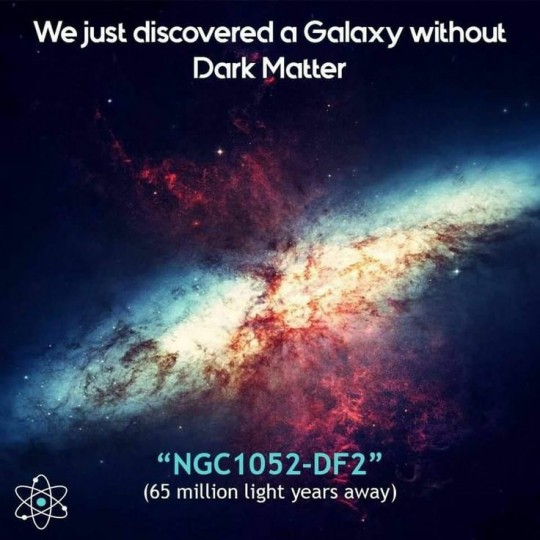
#galaxies#galaxy#dark matter#theoretical physics#quantum physics#physics#astrophysics#space#stars#planets#deep space
7 notes
·
View notes
Text

Slipped this into my PhD thesis draft I just sent to my adviser
#physics#dark matter#karl marx#communism#fritz zwicky#vera rubin#andromeda galaxy#for context on every previous draft i have sent him hes had like 4 comments for the whole thing so im pretty sure he just skims my work#hed prolly be cool w it even if he found it tho tbh
7 notes
·
View notes